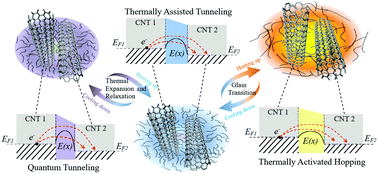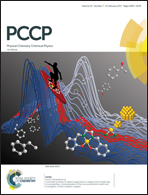Electron tunnelling and hopping effects on the temperature coefficient of resistance of carbon nanotube/polymer nanocomposites†
Abstract
Effectively tailoring the temperature coefficient of resistance (TCR) is critical for multifunctional carbon nanotube (CNT) polymer composites with sensing capability. By developing a new multiscale percolation network model, this work reveals theoretically that the zero-TCR could be achieved by adjusting competing contributions from thermally assisted tunnelling transport at CNT junctions and thermal expansion of matrices. On the other hand, the negative temperature coefficient of nanocomposites above glass transition temperature could be greatly enhanced because the transport mechanism at the CNT junctions experienced a transition from tunnelling to hopping. Both tube–tube and/or tube–matrix interactions at conjunction and the structural distortion of nanotubes are considered in the newly proposed model. To validate the model, CNT/polymer nanocomposites with nearly constant resistance values (zero-TCR) below the glass transition temperature and a high TCR (98% resistance change ratio) resulting from the glass transition of the polymer matrix are successfully developed. The study also suggests that the desired parameters to achieve the zero-TCR property and the potential resistance change ratio could be improved by the glass transition in nanocomposites. This could be beneficial for the development of high quality sensing materials.



 Please wait while we load your content...
Please wait while we load your content...